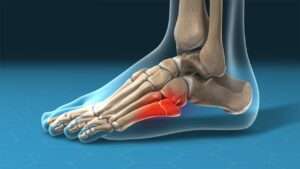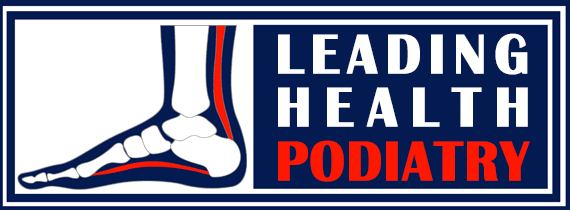Styloid Process Avulsion Fractures
What is a Styloid Process Avulsion Fracture?
A styloid process avulsion fracture occurs when the tendon or ligament attached to a bone pulls off a small fragment of bone. Unlike regular fractures, which involve a sudden break, or stress fractures, which develop gradually, an avulsion fracture is the result of tension or force pulling on the bone.
This type of fracture is commonly found at the base of the fifth metatarsal, which is the bone in the midfoot connected to the fifth toe. You can feel a bump along the outer edge of your foot, known as the styloid process, where the fracture occurs. This area has a relatively poor blood supply, leading to slower and more painful healing.

Who Is At Risk of an Avulsion Fracture and Why?
Anyone can sustain an avulsion fracture through an accidental twist of the foot, such as an ankle sprain or misstep. However, individuals who repetitively overuse a muscle running along the outside of the leg, known as the peroneus brevis, are at higher risk. This muscle attaches to the styloid process, and when it becomes tight and pulls repeatedly, it can cause a fracture.
Dancers, especially ballet dancers who spend significant time on their toes, are more susceptible to this injury. Symptoms often include pain along the outside of the foot, radiating pain up the leg, swelling, bruising, and difficulty walking or wearing shoes due to pain.
Avulsion Fracture Treatment
First Steps
If you’ve just sustained an injury, the first thing you should do is rest your foot, elevate it, apply ice to reduce swelling, and use a compression bandage if available. Over-the-counter non-steroidal anti-inflammatory drugs (NSAIDs) like Nurofen can help reduce both swelling and pain.See Your Podiatrist
Next, it’s crucial to see a podiatrist for a proper assessment. Because these fractures heal slowly, timely and effective treatment is vital. Your podiatrist may recommend a moon boot or walker to immobilize the foot, along with custom foot orthotics designed to alleviate pressure from the fracture site. Adjustments to your footwear and daily activities will be necessary to promote healing. No physical therapy should be initiated until sufficient healing has taken place.Surgery
In severe cases, surgery might be required to repair the fracture. If surgical intervention is necessary, your podiatrist will refer you to a specialist.
Recovery and Healing Time
Healing from a styloid process avulsion fracture can take anywhere from six weeks to four months depending on the severity of the injury. If complications arise, it may take longer to return to full activity. Following the recommended treatment plan is essential to ensure optimal healing and reduce the risk of further damage.
If you suspect a styloid process avulsion fracture or are experiencing any symptoms, book an appointment with a podiatrist at Leading Health Podiatry for expert diagnosis and treatment.
